| Oracle Business Intelligence Publisher User's Guide Release 10.1.3.2 Part Number B40017-01 |
|
|
View PDF |
| Oracle Business Intelligence Publisher User's Guide Release 10.1.3.2 Part Number B40017-01 |
|
|
View PDF |
| Oracle Business Intelligence Publisher User's Guide Release 10.1.3.2 Part Number B40017-01 |
Contents |
 Previous |
 Next |
Note: You must be assigned the BI Publisher Developer role or BI Publisher Administrator role to create or edit reports.
Creating a new report consists of the following steps:
Create the report entry in the desired folder on the Reports page.
Open the Report Editor.
Specify the general properties for the report.
Define the Data Model.
Your report data may come from a SQL query, an HTTP feed, a Web service, an Oracle BI Answers request, a file, or BI Publisher's data template.
Define the parameters that you want users to pass to the query, and define lists of values for users to select parameter values.
Test your data model.
Design the layout template.
If you are designing an RTF template, load the data to the Template Builder for Word. Use the Template Builder in conjunction with the instructions in Creating an RTF Template to build your report layout.
If you are designing a PDF template, follow the instructions in Creating a PDF Template to build your report layout.
If you are using a predesigned PDF form (such as a government form) follow the instructions under Mapping Data to PDF Form Fields.
Upload your templates to the Report Editor.
(Optional) Enable bursting.
(Optional) Add translations for your reports. See Translating Reports.
Note: You must be assigned the BI Publisher Developer role or BI Publisher Administrator Role to create or upload reports.
Navigate to the folder in which you want the new report to reside.
To create a new folder for this report, select the Create a new folder link.
Select the Create a new report link from the Folder and Report Tasks menu. This will invoke a text box for you to enter the name of your new report.

Enter the name for your new report and select Create. This creates the listing for your report within the current folder.
Select the Edit link for the new report entry. This invokes the Report Editor.
Report Editor
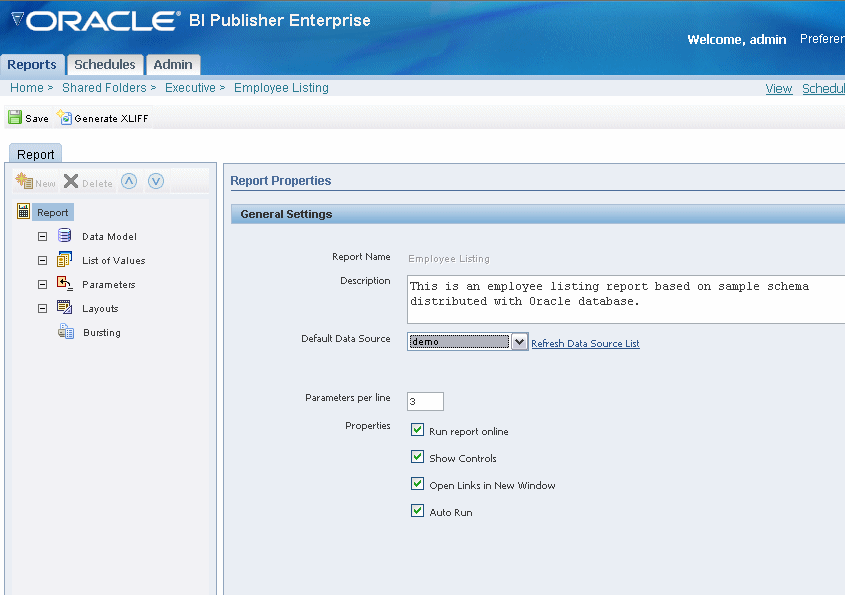
Enter the Report Properties:
Description - the description will display beneath the report name within the report folder.
Default Data Source - select the data source from the list of values. You may define multiple data sources for your report when you define the Data Model. The Default Data Source you select here will be presented as the default for each new data set you define. Select Refresh Data Source List to see any new data sources added since your session was initiated.
Parameters per line - enter the number of parameters that you want to display before creating a second parameter line for the report. The parameter line is displayed in the online report View page and the Schedule page.
Run report online - select this box to enable this report in the online viewer. If not selected, users will be able to Schedule the report only.
Show controls - select this box so that all users can see the control region of the report. Control region consists of the Template list, Output list, and Parameter lists.
Open Links in New Window? - select this box to open any links contained in the report in a new browser window.
Auto Run - select this box to automatically run the report when the user selects the report or the View link for the report within the report folder. When Auto Run is not turned on, selecting the report or the View link for the report displays the online Viewer and parameters for the report only. The user must select the View button from the online Viewer to run the report.
Select the Save icon to save your report definition.
BI Publisher requires XML data to publish reports. The XML data can come from any of the following sources:
SQL query
HTTP (XML feed)
Web service
Data Template
Oracle BI Answers request
File
You can define multiple data sets for one report and each data set can have a different data source and source type. When you define multiple SQL queries, you can concatenate the resulting data sets.
Select Data Model.
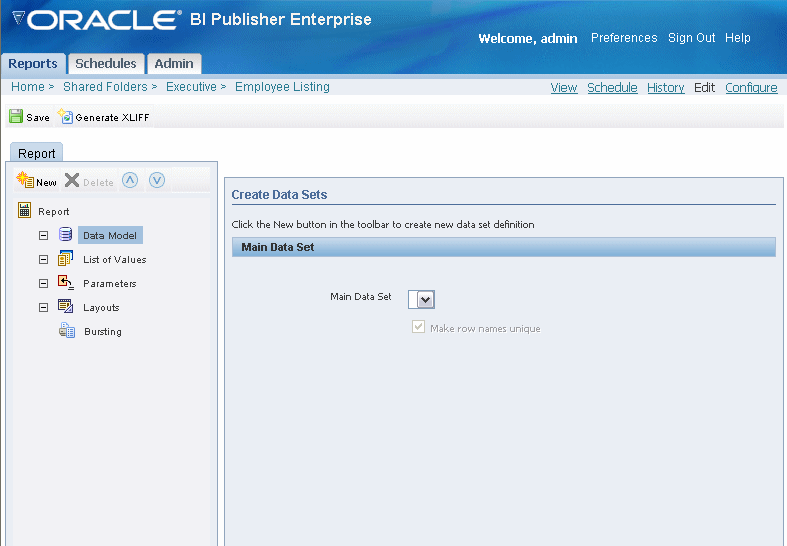
This will display the Main Data Set list. This list will be empty until you define a data set. To define a data set, select New.
Enter a Name and Type for the data set. The Type can be:
SQL Query
HTTP (XML Feed)
Web Service
Data Template
Oracle BI Answers
File
Important: If your data set is a Web Service or HTTP (XML Feed) you must define any parameters before you define the data set.
After you have defined your data sets, select Data Model. The data sets that you have defined will now populate the list for Main Data Set. Select the data set that will be used to generate the report.
Note: If you are defining multiple data sets from SQL queries, you can combine them into a single data set by selecting Concatenated SQL Data Source. It is strongly recommended that you select Make row names unique if you are concatenating datasets.
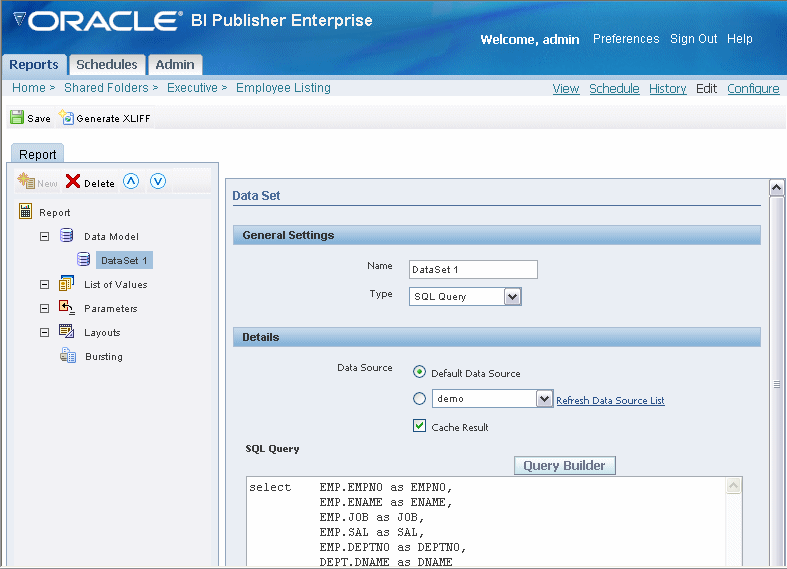
Select the Data Source for this data set. Select the Default Data Source (defined in the Report Properties) or select a new data source from the list.
Select the Cache Result box if you wish to cache the results of the query for your session.
By caching the results of the query, multiple templates can be applied to these results without requerying the data. This will enhance online performance. However, if the data is updated during the session, the user cannot view the new data via the View report page until the cache is cleared.
Note: You can control the cache expiration time and the cache size through the configuration settings. See Setting Server Configuration Options for more information.
Enter the SQL query or select Query Builder. See Using the Query Builder for information on the Query Builder utility.
Use the Query Builder to build SQL queries without coding. The Query Builder enables you to search and filter database objects, select objects and columns, create relationships between objects, and view formatted query results with minimal SQL knowledge.
The Query Builder page is divided into three sections:
Object Selection pane contains a list objects from which you can build queries. Only objects in the current schema display.
Design pane displays selected objects from the Object Selection pane.
Output pane allows you to create conditions, view the generated SQL, or view query results.

To build a query, perform the following steps:
Select objects from the Object Selection pane.
Add objects to the Design pane and select columns.
Optional: Establish relationships between objects.
Optional: Create query conditions.
Execute the query and view results.
In the Object Selection pane you can select a schema and search and filter objects.
To hide the Object Selection pane, select the control bar located between it and the Design pane. Select it again to unhide it.
The Schema list contains all the available schemas in the data source. Note that you may not have access to all that are listed.
Use the Search field to enter a search string. Note that if more than 100 tables are present in the data source, you must use the Search feature to locate and select the desired objects.
The Object Selection pane lists the tables, views, and materialized views from the selected schema (for Oracle databases, synonyms are also listed). Select the object from the list and it displays on the Design pane. Use the Design pane to identify how the selected objects will be used in the query.
Columns of all types display as objects in the Design pane. Note the following column restrictions:
Each can select no more than 60 columns for each query.
Only the following column types are selectable:
VARCHAR2, CHAR
NUMBER
DATE, TIMESTAMP
BLOB
Note: The BLOB must be XML or an image. When you execute the query in the Query Builder, the BLOB will not display in the Results pane, however, the query will be constructed correctly when saved to the Report Editor.
XMLType
Note: When you execute the query in the Query Builder, the XMLType will display as null. When you save the query to the Report Builder, you must add the function (such as getClobval()) to extract the XML from the type.
Select an object.
The selected object displays in the Design pane. An icon representing the datatype displays next to each column name.
Select the check box for each column to include in your query.
When you select a column, it appears on the Conditions tab. Note that the Show check box on the Conditions tab controls whether a column is included in query results. Be default, this check box is selected.
To select the first twenty columns, click the small icon in the upper left corner of the object and then select Check All.
To execute the query and view results, select Results.
Tip: You can also execute a query using the key strokes CTRL + ENTER.
As you select objects, you can resize the Design and Results panes by selecting and dragging the gray horizontal rule dividing the page.
To remove an object, select the Remove icon in the upper right corner of the object.
To temporarily hide the columns within an object, click the Show/Hide Columns icon.
Conditions enable you to filter and identify the data you want to work with. As you select columns within an object, you can specify conditions on the Conditions tab. You can use these attributes to modify the column alias, apply column conditions, sort columns, or apply functions.
When you select a column to include in your query, it appears as a separate row in the Output pane. The following table describes the attributes available on the Conditions tab:
| Condition Attribute | Description |
|---|---|
| Up and Down Arrows | Controls the display order of the columns in the resulting query. |
| Column | Displays the column name. |
| Alias | Specify an optional column alias. An alias is an alternative column name. Aliases are used to make a column name more descriptive, to shorten the column name, or prevent possible ambiguous references. |
| Condition | The condition modifies the query's WHERE clause. When specifying a column condition, you must include the appropriate operator and operand. All standard SQL conditions are supported. For example: >=10 ='VA' IN (SELECT dept_no FROM dept) BETWEEN SYSDATE AND SYSDATE + 15 |
| Sort Type | Select ASC (Ascending) or DESC (Descending). |
| Sort Order | Enter a number (1, 2, 3, and so on) to specify the order in which selected columns should display. |
| Show | Select this check box to include the column in your query results. You do not need to select Show if you need to add a column to the query for filtering only. For example, suppose you wish to create following query: SELECT ename FROM emp WHERE deptno = 10 To create this query in Query Builder:
|
| Function | Available argument functions include:
|
| Group By | Specify columns to be used for grouping when an aggregate function is used. Only applicable for columns included in output. |
| Delete | Deselect the column, excluding it from the query. |
As you select columns and define conditions, Query Builder writes the SQL for you.
To view the underlying SQL, click the SQL tab
You can create relationships between objects by creating a join. A join identifies a relationship between two or more tables, views, or materialized views.
When you write a join query, you specify a condition that conveys a relationship between two objects. This condition is called a join condition. A join condition determines how the rows from one object will combine with the rows from another object.
Query Builder supports inner, outer, left, and right joins. An inner join (also called a simple join) returns the rows that satisfy the join condition. An outer join extends the result of a simple join. An outer join returns all rows that satisfy the join condition and returns some or all of those rows from one table for which no rows from the other satisfy the join condition.
Note: See Oracle Database SQL Reference for information about join conditions.
Create a join manually by selecting the Join column in the Design pane.
From the Object Selection pane, select the objects you want to join.
Identify the columns you want to join.
You create a join by selecting the Join column adjacent to the column name. The Join column displays to the right of the datatype. When your cursor is in the appropriate position, the following help tip displays:
Click here to select column for join
Select the appropriate Join column for the first object.
When selected, the Join column is darkened. To deselect a Join column, simply select it again or press ESC.
Select the appropriate Join column for the second object.
When joined, line connects the two columns. An example is shown in the following figure:
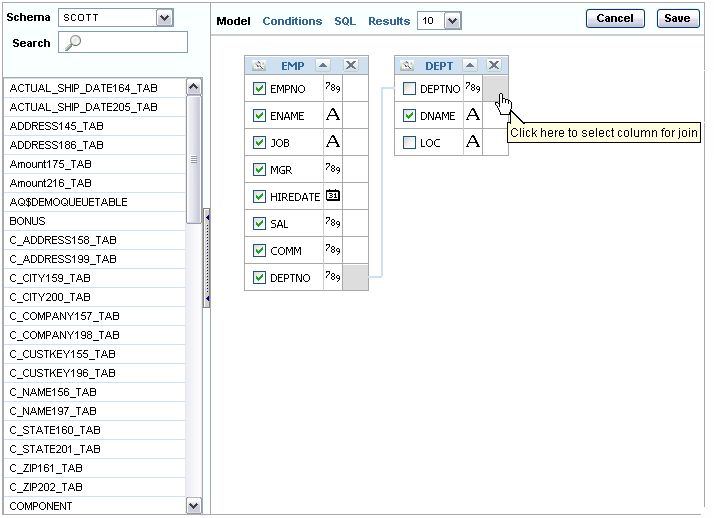
Select the columns to be included in your query. You can view the SQL statement resulting from the join by positioning the cursor over the join line.
Click Results to execute the query.
Once you have built the query and executed it, select the Save button to return to the Report Editor. The query will appear in the SQL Query box.
Once you have saved the query from the Query Builder to the Report Editor, simply select Query Builder again to edit the query. The Query Builder will parse the query and present it for modification in the Query Builder interface.
Using the HTTP data source type you can create reports from RSS feeds over the Web.
Note that if you want to include parameters for an HTTP (XML feed), you must define the parameters first, so that they are available for selection when setting up the data source. See Adding Lists of Values and Parameters.
Enter the URL for the XML feed.
Select the Method: Get or Post.
Enter the Username, Password, and Realm for the URL, if required.
Select the Cache Result box if you wish to cache the results of the query for your session.
By caching the results of the query, multiple templates can be applied to these results without requerying the data. This will enhance online performance. However, if the data is updated during the session, the user cannot view the new data via the View report page until the cache is cleared.
Note: You can control the cache expiration time and the cache size through the configuration settings. See Setting Server Configuration Options for more information.
To add a parameter, select the Add link. Enter the Name and select the Value. The Value list is populated by the parameter Identifiers defined in the Parameters section. See Adding Parameters and Lists of Values.

BI Publisher supports document/literal Web service data sources that return XML as a string.
Tip: If the WSDL URL is outside of your company firewall remember to start the server up with the proxy parameters.
Note that if you want to include parameters for the Web service method, you must define the parameters first, so that they are available for selection when setting up the data source. See Adding Parameters and Lists of Values.
Multiple parameters are supported. Ensure the method name is correct and the order of the parameters matches the order in the method. If you want to call a method in your Web service that accepts two parameters, you must map two parameters defined in the report to those two. Note that only parameters of simple type are supported, for example, string and integer.
Enter the WSDL URL and the Web Service Method.
Important: Only document/literal Web services are supported.
To specify a parameter, select the Add link. Select the parameter from the list.
Note: The parameters must already be set up in the Parameters section of the report definition See Adding Parameters and Lists of Values.
This example shows how to add a Web service to BI Publisher as a data source. The Web service returns stock quote information. The Web service will pass one parameter: the quote symbol for a stock.
The WSDL URL is:
http://www.webservicex.net/stockquote.asmx?WSDL
If you are not already familiar with the available methods and parameters in the Web service that you want to call, you can open the URL in a browser to view them. This Web service includes a method called GetQuote. It takes one parameter, which is the stock quote symbol.
To add the Web service as a data source:
Enter the Data Set information:
Enter a Name for the Data Set and select Web Service as the Type.
Enter the WSDL URL: http://www.webservicex.net/stockquote.asmx?WSDL
Enter the Method: GetQuote
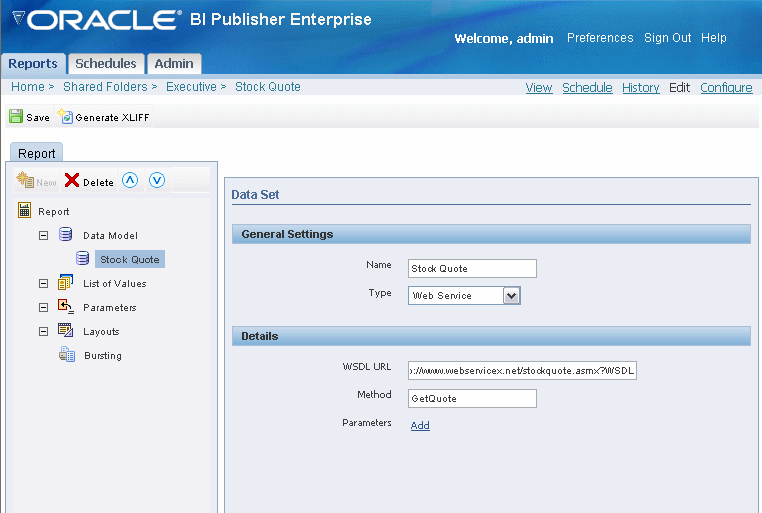
Define the parameter to make it available to the Web service data set.
Select Parameters on the Report definition pane and click New to create a new parameter. Enter the following:
Identifier - enter an internal identifier for the parameter.
Data Type - String
Default Value - if desired, enter a default for the parameter.
Parameter Type - Text
Display label - enter the label you want displayed for your parameter.
Text Field Size - enter the size for the text entry field in characters.
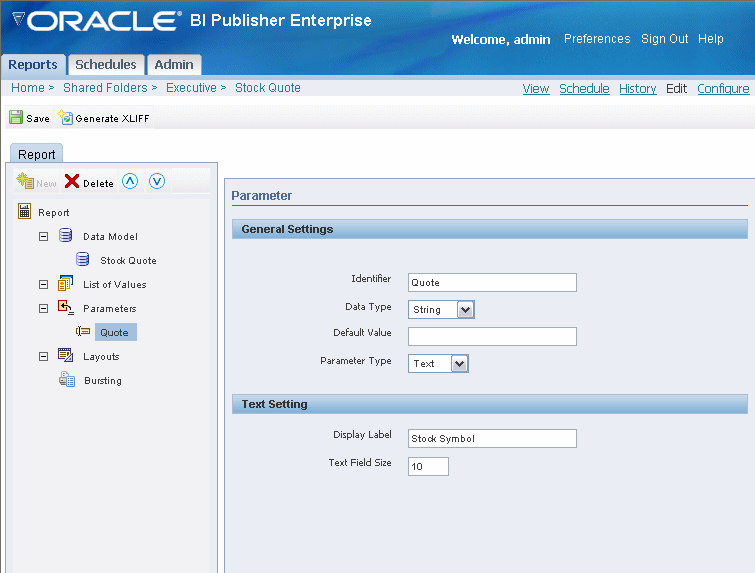
Return to your Web service data set and add the parameter.
In the Details section under Parameters, Select Add. The Quote parameter you specified is now available from the list.
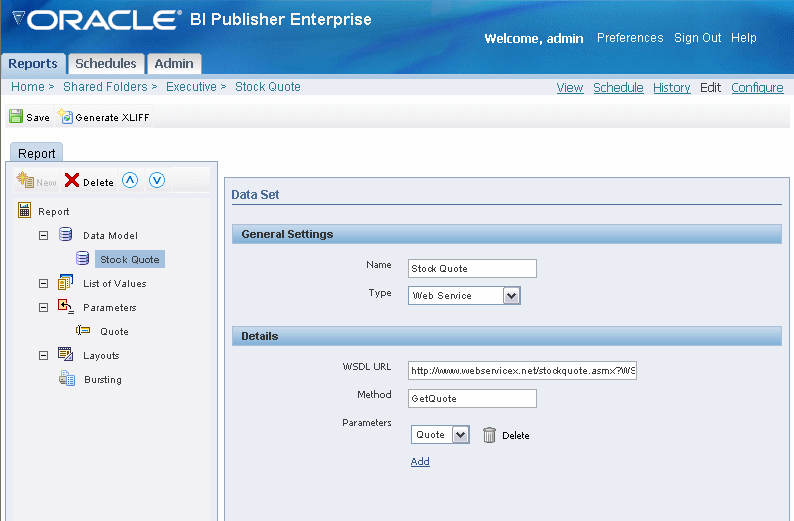
To view the results XML, select View. Enter a valid value for your Stock Quote parameter and select View again.
Use the BI Publisher data template to create more complex SQL queries. See Building a Data Template for features and usage. Please note that lexical parameters are only supported when executing a query against an Oracle E-Business Suite instance.
Enter the data template code directly in the Data Template text box, or copy and paste the data template from another text source.
Important: If copying the data template, the entry in the text box must begin with the <dataTemplate> element. Do not include the XML declaration.
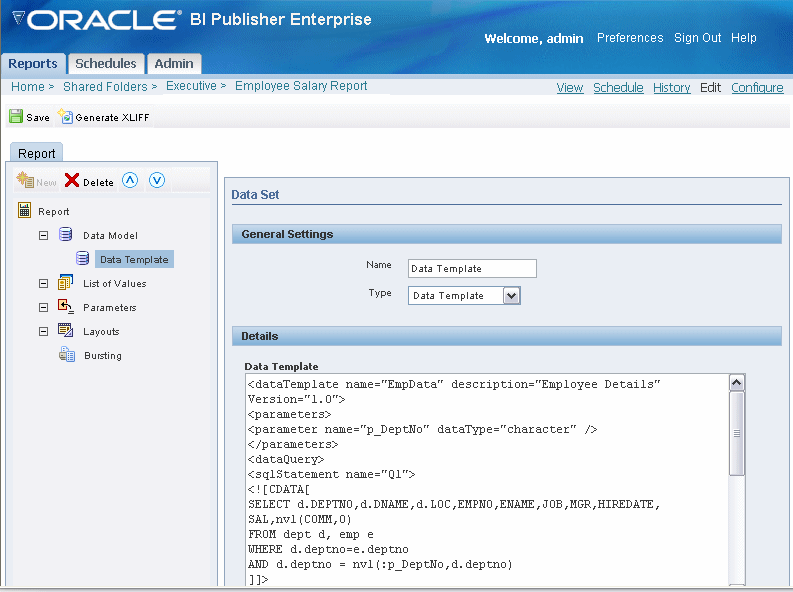
If you have enabled integration with Oracle Business Intelligence Presentation Services, then you can access the BI catalog to select an Oracle BI Answers request as a data source. Oracle BI Answers is an ad hoc query building tool included in the Oracle Business Intelligence Enterprise Edition. For more information on building Oracle BI Answers see the Oracle Business Intelligence Answers, Delivers, and Interactive Dashboards User Guide.
Choose Oracle BI Answers as the data set Type.
Note: BI Publisher does not support lists of values and parameters for the Oracle BI Answers request data set type.
Select the browse icon to connect to the Oracle BI Answers catalog. This action displays the folders you have access to on the Oracle BI Presentation Services server.
Note: You must set up integration with Oracle BI Presentation Services to enable Oracle BI Answers as a data set Type. See
Select the Answers request you wish to use as the data set for your report.
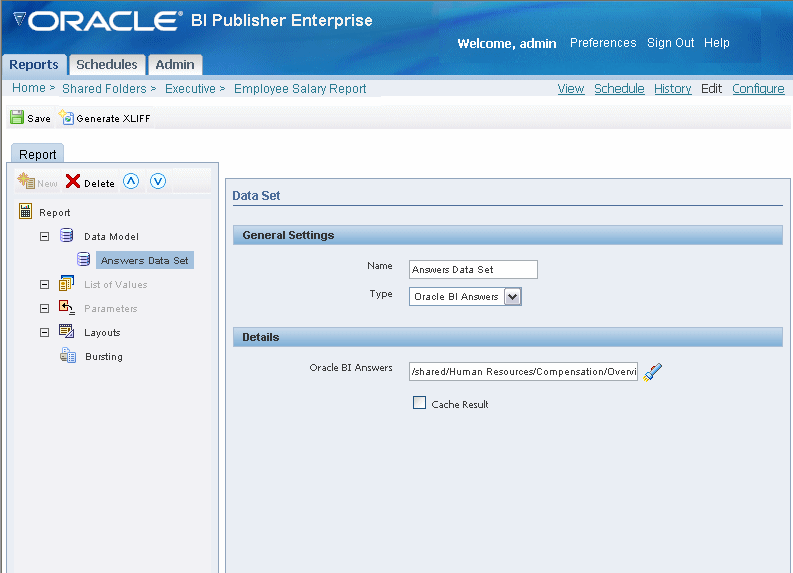
Select the Cache Result box if you wish to cache the results of the query for your session.
By caching the results of the query, multiple templates can be applied to these results without requerying the data. This will enhance online performance. However, if the data is updated during the session, the user cannot view the new data via the View report page until the cache is cleared.
Note: You can control the cache expiration time and the cache size through the configuration settings. See Setting Server Configuration Options for more information.
When you set up data sources (see Setting Up Data Sources) you can define a file directory as a data source. You can then place xml documents in the file directory to access directly as data sources for your reports.
Choose File as the data set Type.
Choose the appropriate file directory as the Data Source.
Enter the File Name of the XML document to use as the report data set. If the file resides in a subdirectory, include the path.
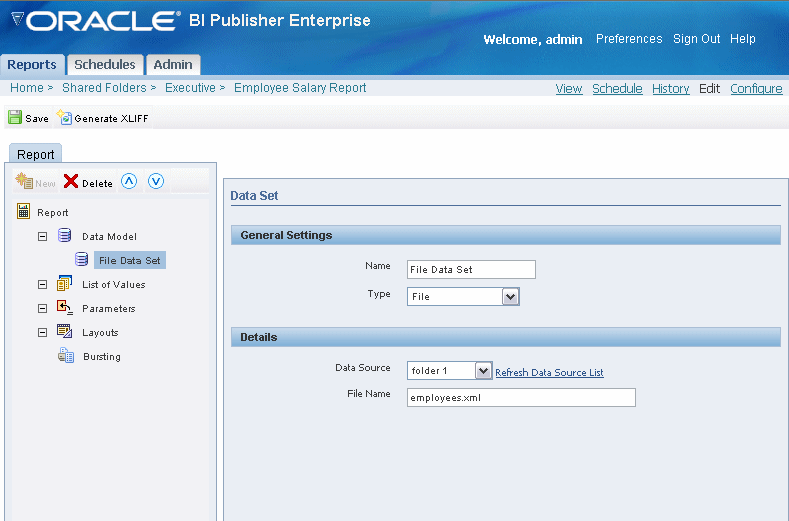
Add parameters to your report definition to enable your users to interact with the report and specify the data of interest from the data set; or specify hidden parameters to control the data returned to a user from a data set.
Note: Parameters are not supported for Oracle BI Answers request data set type.
BI Publisher supports the following parameter types:
Text - allows the user to enter a text entry to pass as the parameter.
Menu - allows the user to pass parameters by making selections from a list of values. This option supports multiple selections, a "Select All" option, and partial page refresh for cascading parameters. Define the properties for the list of values in the report definition. A list of values can contain fixed data that you specify or the list can be created via a SQL query executed against any of the defined data sources.
To add a parameter as a menu, define the list of values first. Then define the parameter and associate it to the list of values. See Adding a List of Values.
Date
Hidden - enables you to pass the default value always, without allowing the user to see or change it.
Adding a List of Values:
Select List of Values and then select the New icon in the toolbar. This will create a New List of Values entry.
Enter a Name for the list and select a Type: SQL Query or Fixed Data.

If you select SQL Query:
Select a Connection from the data source list.
Select Cache Result if you want the results of the query cached for the report session.
Enter the SQL query or use the Query Builder. See Using the Query Builder for information on the Query Builder utility.
If you select Fixed Data:
Select the Add link to add the Label and Value pairs for the LOV.
Select Parameters and then select the New icon to define parameters for the report.
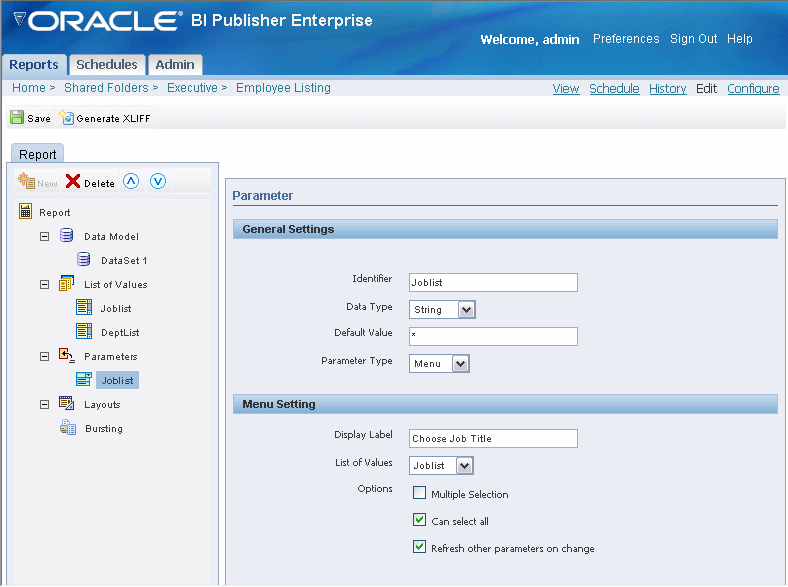
Enter a name Identifier and the Data Type (String, Integer, Boolean, Date, or Float).
Enter a Default Value for the parameter, if desired. Enter * to pass All as the default.
Note: Using * passes a null, so you must handle the null in your data source. A method to handle the null would be the standard Oracle NVL command, for example:
where customer_id = nvl(:cstid, customer_id)
where cstid is a value passed from the LOV and when the user selects All it will pass a null value.
If your data source is the Oracle BI Server, use the following macro to handle the null:
{$ if ${sYear}='*'$}
{$elsif ${sYear}='2000' $}
where Year = :sYear
{$else $}
where Year = :sYear
{$endif$}
where Year is a value passed from the LOV and when the user selects All it will pass a null value.
Note that the test operator must be either "=" or "!=".
Select the Parameter Type:
Text - this type allows the user to enter a text entry to pass as the parameter. Enter the Display Label for the parameter and the Text Field Size in characters.
Menu - this type presents an LOV. Enter the Display Label and select from the LOVs you defined in the previous step. You may also enable the following options:
Multiple Selection - allows the user to select multiple entries from the list.
Can select all - inserts an "All" option in the list.
Refresh other parameters on change - performs a partial page refresh to refresh any other parameters whose values are dependent on the value of this one.
Date - passes a date parameter. If you select a Parameter Type of Date, the Data Type automatically defaults to Date. Enter the following:
Display Label and Text Field Size in characters.
Date Format String
Date From and Date To
Hidden - select this option to pass the default value always, without allowing the user to see or change it.
BI Publisher offers several options for designing templates for your reports. Templates can be in any of the following formats:
Rich Text Format (RTF)
RTF is the most common template type. Use Microsoft Word to design the template. Most Microsoft Word formatting features are supported. BI Publisher provides a plugin utility for Microsoft Word that automates template design and enables you to connect to BI Publisher to access data and upload templates directly from your Word session.
Portable Document Format (PDF)
PDF templates are used primarily for using predefined forms as templates for your reports. For example, you can download forms from government Web sites and load them to BI Publisher as report templates. You can also design your own PDF templates using Adobe Acrobat Professional. BI Publisher provides a mapping tool to enable you to map fields from your data source to the form fields in the PDF template.
Microsoft Excel (XLS)
Use BI Publisher's Analyzer for Excel to download your report data to an Excel spreadsheet. Create a layout for the data in Excel and then upload the spreadsheet back to BI Publisher to use as a template. See Using the BI Publisher Analyzer for Excel.
XSL Stylesheet
You can define a template in XSL formatting language. Specify whether your template is for FO, HTML, XML, or Text transformation. To add your template, follow the steps in Adding a Layout - General Steps.
eText
These are specialized RTF templates used for constructing EDI or EFT transactions. See Creating an eText Template. To add your template, follow the steps in Adding a Layout - General Steps.
To add a layout to your report definition, select Layouts to specify the layout template for the report. Defining layouts consists of two steps: Upload a template file, and then assign the template file to a Layout definition. If you are connected to BI Publisher through the Template Builder or Excel Analyzer, you can upload the layout file in one step.
Note: To build a template for your report, you must have sample data. Once you have defined your query, you can select the View link to generate XML. Select the Export button and save the file to your local directory. If you are building an RTF template or Excel template you can load this data directly to the Template Builder for Word or Excel using BI Publisher's desktop tools described in the following sections.
For information on creating template layout files, see Creating an RTF Template or Creating a PDF Template.
To add a layout to your report definition, select Layouts to specify the layout template for the report. Defining layouts consists of two steps: Upload a template file, and then assign the template file to a Layout definition. If you are connected to BI Publisher through the Template Builder or Excel Analyzer, you can upload the layout file in one step.
See Creating an RTF Template Using the Template Builder for Word.
The general guidelines for uploading and defining the layout for any template type are as follows:
Upload your layout template file.
From the BI Publisher Report Editor. Select Layouts.
Use the Browse button to locate it in your local file system, then select Upload. The template will now appear in the Manage Template Files region. You can upload as many templates as you want to make available to this report.
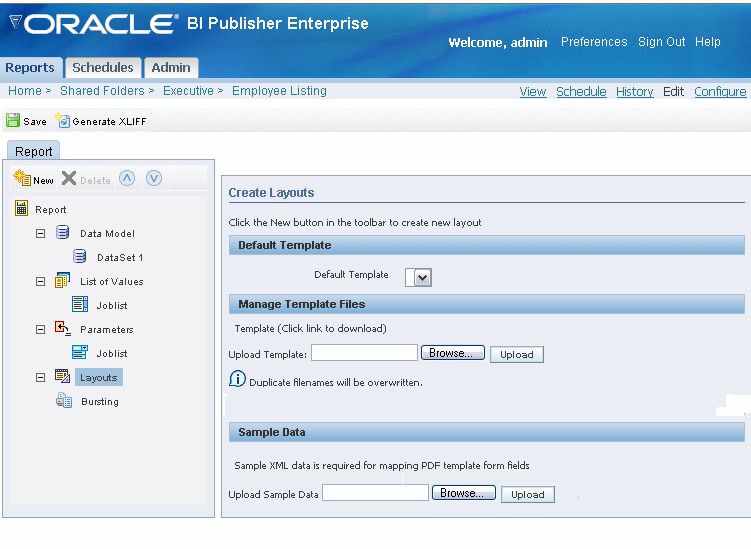
Select the New icon to create the definition for the new template.
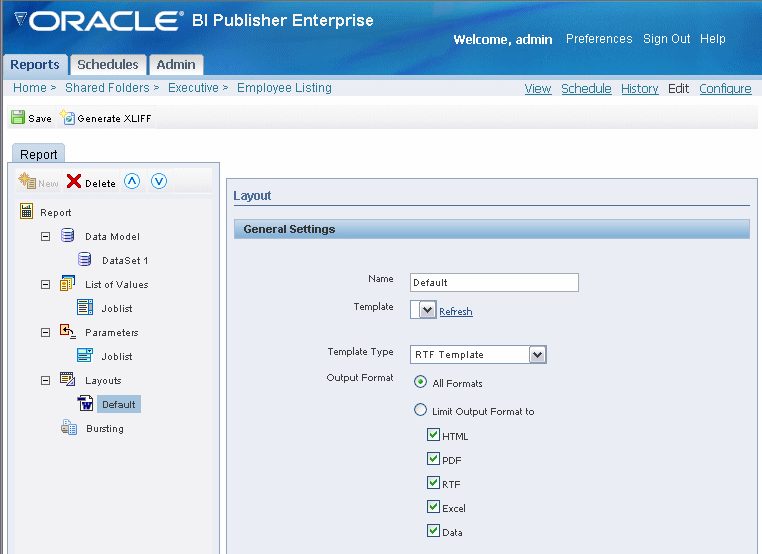
Enter a Name for the layout definition. This name will appear in the Template list on the View report page.
Select the Template file from the list of uploaded templates to correspond to this layout definition.
Select the appropriate template type you are uploading: RTF, PDF, Excel, XSL, or eText.
Select the Output Format types to allow for this layout.
If the template type is RTF, you can either select All Formats or limit the allowed formats by selecting only those desired.
All other template types have specific output formats. For these, All Formats is automatically selected. The allowed output type for each of the other template types is the same as the template type (example: PDF Templates allow PDF output only).
Note: You can also manage the output types allowed through the Runtime Configuration properties. However, the setting on the report definition will override the configuration. See Setting Runtime Properties.
Select Save. The Layout will now appear as an available template when you run the report.
Select a Default Template. The Default Template will be used by default by the online viewer and the scheduler unless the user selects another.
Your report data model has been created and runs successfully.
Microsoft Word version 2000 or later and Microsoft Windows version 2000 or later are installed on your client.
The Template Builder has been downloaded and installed on your client.
The Template Builder can be downloaded from the BI Publisher Folder and Report Tasks region.

When you open Microsoft Word after installing the Template Builder you will notice the Oracle BI Publisher menu and the BI Publisher toolbar.

The toolbar and the menu provide two methods of performing many of the same functions, including:
Insert data fields into your RTF templates
Insert tables, forms, charts, and crosstabs
Preview your template in multiple outputs
Browse and update the content of form fields
Validate your template
Perform calculations on fields within the template
Connect to the Oracle BI Publisher server or the Oracle BI server to retrieve data to build your template
Publish your template to the Oracle BI Publisher server
Extract boilerplate text into an XLIFF translation file and test translations
You can build and upload your template via a direct connection with the BI Publisher server, or you can build and upload your template in disconnected mode.
Open Microsoft Word.
From the Oracle BI Publisher menu, select Log On.
Enter your BI Publisher credentials and the URL for the BI Publisher server. (Contact your system administrator if you do not know the URL.)
The Open Template dialog presents the same folder structure as your BI Publisher Reports home page. Select the report for which you want to build a template.
Select Open Report to load the data to the Template Builder; or double-click <New> in the Layout Templates pane.
Note that any existing templates will be listed in the Layout Templates pane.

Follow the guidelines in the Template Builder online help (from the Oracle BI Publisher menu) to insert data fields and design your template using features such as tables, charts, graphics, and crosstabs. Use Microsoft Word to apply formatting to fonts and other objects in your template.
For more advanced template options, use the guidelines in Creating an RTF Template.
To upload your template to the BI Publisher server and add it to your report definition, select Publish Template As from the Oracle BI Publisher menu.
If you have not saved your template, you will be prompted to save it in Rich Text Format.
Enter a name for your template in the Upload as New dialog. Note that this is the name that appears under Layouts in the Report Editor. This is also the template name that will be displayed whenever the user is presented an option for selecting a template for this report (for example, in the View Report page).
(Optional) Limit the output formats for this template.
From the BI Publisher Enterprise interface, open the report in the Report Editor. Under Layouts, select your uploaded template. If you wish to limit the output formats for this report, select only the formats you want to make available.
From the Report Editor:
Generate a sample data file.
From the Report Editor or from the Reports page, select View. If no layouts are defined for your report, then the output type will default to xml, otherwise, choose data for the output type. Select Export. Save the results as an XML file to a local directory.
Open Microsoft Word with the Template Builder installed.
From the Oracle BI Publisher menu select Data and then select Load Sample XML Data. Locate your sample data file in your local directory and select Open. A pop up message will indicate your data has loaded successfully.
Follow the guidelines in the Template Builder online help (from the Oracle BI Publisher menu) to insert data fields and design your template using features such as tables, charts, graphics, and crosstabs. Use Microsoft Word to apply formatting to fonts and other objects in your template.
For more advanced template options, use the guidelines in Creating an RTF Template.
Upload your layout template file.
Return to your report definition in the BI Publisher Report Editor. Select Layouts.
Use the Browse button to locate it in your local file system, then select Upload. The template will now appear in the Manage Template Files region. You can upload as many templates as you want to make available to this report.

Select the New icon to create the definition for the new template.

Enter a Name for the layout definition. This name will appear in the Template list on the View report page.
Select the Template file from the list of uploaded templates to correspond to this layout definition.
Select the appropriate template type: RTF or PDF.
Select the Output Format types to allow for this layout.
If the template type is RTF, you can either select All Formats or limit the allowed formats by selecting only those desired.
If the template type is PDF, All Formats is automatically selected. The only allowed output type for a PDF template is PDF.
Note: You can also manage the output types through the Runtime Configuration Properties. However, the setting on the report definition will override the configuration setting. For more information, see Setting Runtime Properties.
Typically, the source for a PDF template is a predefined form from a third party, such as the government. If form fields have already been defined in the PDF, then you have two options for associating the XML data to the PDF form fields:
Map the data fields to the form fields in the PDF, using BI Publisher's PDF mapping tool
Name the fields from your data source to match the names of the form fields.
If you are creating a report to be used exclusively for the preparation of a PDF form, then consider naming the fields in your data according to the form field names in the PDF. If the field names match, no mapping is required.
If the predefined PDF does not have form fields defined, or if you wish to design your own PDF template, then you must use Adobe Acrobat Professional to insert the form fields. You can then either name the fields according to the data source (no mapping will be required) or use BI Publisher's PDF mapping tool. For information on designing a PDF template and inserting form fields, see Creating a PDF Template.
If you have the full version of Adobe Acrobat 5.0 or later:
Open the file in Adobe Acrobat.
Select the Text Field Tool (Adobe Acrobat Professional 6.0 users) or the Form Tool (Adobe Acrobat 5.0 users). This will highlight text fields that have already been defined. If no fields are highlighted then you must add the fields to the PDF. See Adding Markup to the Template Layout for instructions on inserting PDF form fields.
The following figure shows a sample PDF form opened in Adobe Acrobat Professional 6.0. The Text Field Tool has been selected to display all the available form fields.
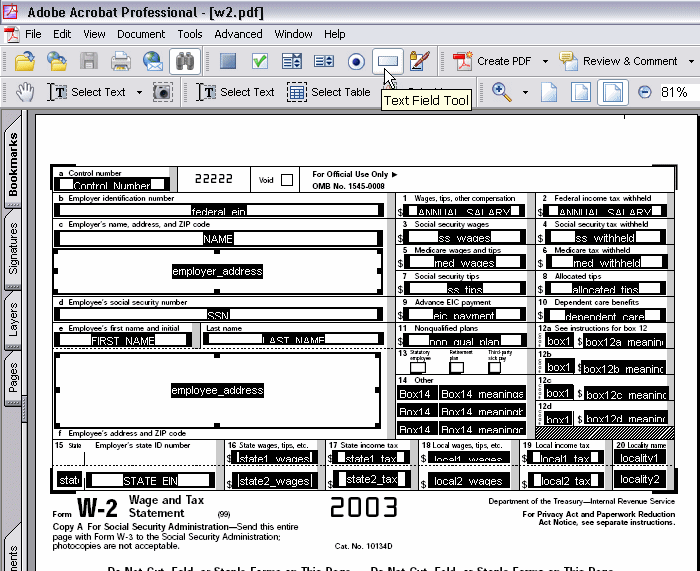
If you do not have the full version of Adobe Acrobat 5.0 or later:
Follow the instructions in Adding a Predefined PDF Form as a Template.
If no highlighted fields display for mapping, or you cannot select a field, then you must add them before you can use BI Publisher's mapping tool. Adding form fields requires Adobe Acrobat 5.0 or later, or Adobe Acrobat Professional 6.0 or later. For more information, see Creating a PDF Template.
Prerequisites:
A report data model defined in BI Publisher.
A PDF document with form fields defined.
Adobe Acrobat Reader installed as a Web browser plugin. Recommended version is Adobe Acrobat Reader 7.0 or later. (You can use Acrobat Reader 6 if English is the only language required for your site.)
From the Report Editor, select Layouts.
Upload the PDF template file.
From the Manage Template Files region, select Browse to locate the PDF file, and then select Upload.
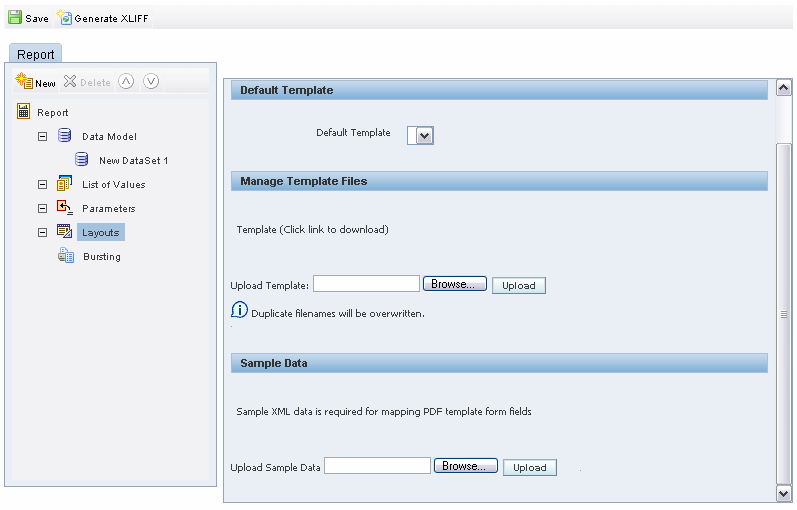
Generate a sample data file.
From the Report Editor or from the Reports page, select View. If no layouts are defined for your report, then the output type will default to xml, otherwise, choose data for the output type. Select Export. Save the results as an XML file to a local directory.
Upload the sample data file.
From the Report Editor, Layouts pane, in the Sample Data region, browse for and upload your sample data file.
Map the PDF form fields.
Once you have uploaded your template and sample data, the Map Form Fields button will become enabled.

Select Map Form Fields.
The BI Publisher mapping tool will launch in a separate browser window.
Note that as you mouse over the fields, the name of the field in the PDF form will display.

Click in the field on the PDF form that you want to map data to.
A second window will launch, displaying the field names from the sample data that you loaded. Note that the form field selected is shown at the top of the dialog. If the field is already mapped, the dialog will display the name of the data field that it is currently mapped to. In the figure below, ANNUAL_SALARY is the name of the selected form field. It is shown as being mapped to ANNUAL_SALARY in the data (ANNUAL_SALARY = ANNUAL_SALARY).
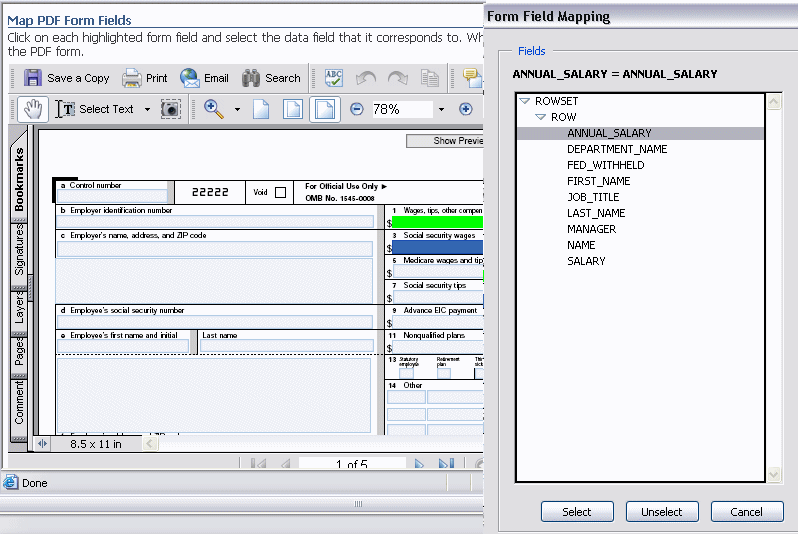
Select the field from the Form Field Mapping dialog and then click Select. This will complete the mapping for the field.
Repeat the selection process for each field that you want to map from the PDF template.
To see a preview of your template with the sample data mapped to the fields, select Show Preview.
When you have mapped all fields, select Submit to save your mapping file.
Note that the PDF mapping file is saved in the report definition as a .map file.
Select the New icon to create the definition for the new template.
Enter a Name for the layout definition. This name will appear in the Template list on the View report page.
Select the Template file from the list of uploaded templates to correspond to this layout definition.
Select the appropriate template type: PDF.
The Output Format for PDF templates defaults to All Formats and does not allow update. PDF output is the only allowed output type for PDF templates.
Using BI Publisher's bursting feature you can split a single report based on a key in the report data and deliver the report based on a second key in the report data. Driven by the delivery key, you can apply a different template, output format, delivery method, and locale to each split segment of your report. Example implementations include:
Invoice generation and delivery based on customer-specific layouts and delivery preference
Financial reporting to generate a master report of all cost centers, bursting out individual cost center reports to the appropriate manager
Generation of payslips to all employees based on one extract and delivered via e-mail
Prerequisite: A report defined in BI Publisher. The report data must contain an element by which the report will be split and an element by which the report will be delivered.
Enabling a report for bursting consists of the following steps:
Open the report in Edit mode.
Select Bursting under the report definition.
Select the Enable Bursting check box.
Select the Split By and Deliver By elements.
The Split By element is the data element from the report file that you wish to split the report by. For example, to split a batch of invoices by each invoice, you may use an element called CUSTOMER_NAME.
The Deliver By element is the data element from the report file by which to determine the delivery method. In the invoice example, it is likely that each invoice will have delivery criteria determined by customer, therefore the Deliver By element may be CUSTOMER_ID.
Select the data source for the delivery XML.
The delivery XML can be sourced from the same data source as the main data set, or it can be generated from a different data source.
Enter the SQL query to build the delivery XML. See Defining the Delivery Data Set for details.
Based on the SQL query that you provide on the Bursting criteria page of the Report Editor, BI Publisher will build the delivery XML data set. The delivery XML data set contains the information to deliver your burst report appropriately to each recipient. The delivery data in this XML document is used as a mapping table for each Deliver By element. The structure of the delivery XML is as follows:
<ROWSET> <ROW> <KEY></KEY> <TEMPLATE></TEMPLATE> <TEMPLATE_FORMAT></TEMPLATE_FORMAT> <LOCALE></LOCALE> <OUTPUT_FORMAT></OUTPUT_FORMAT> <DEL_CHANNEL></DEL_CHANNEL> <PARAMETER1></PARAMETER1> <PARAMETER2></PARAMETER2> <PARAMETER3></PARAMETER3> <PARAMETER4></PARAMETER4> <PARAMETER5></PARAMETER5> <PARAMETER6></PARAMETER6> <PARAMETER7></PARAMETER7> <PARAMETER8></PARAMETER8> <PARAMETER9></PARAMETER9> <PARAMETER10></PARAMETER10> </ROW> </ROWSET>
where
KEY is the Delivery key and must match the Deliver By element. The bursting engine uses the key to link delivery criteria to a specific section of the burst data.
TEMPLATE - is the name of the Layout template to apply. Note that the value is the Layout name (for example, "Invoice"), not the template file name (for example, invoice.rtf).
TEMPLATE_FORMAT - is the format of the layout template. Valid values are:
RTF
ETEXT
XSL_FO
LOCALE - is the template locale, for example, "en-US".
OUTPUT_FORMAT - is the output format. Valid values are:for example: pdf, html, excel.
HTML
RTF
EXCEL
DEL_CHANNEL - is the delivery method. Valid values are:
FAX
FILE
FTP
WEBDAV
Delivery parameters by channel. The delivery parameters by channel are defined in the following table:
| Channel | Parameter 1 | Parameter 2 | Parameter 3 | Parameter 4 | Parameter 5 | Parameter 6 | Parameter 7 |
|---|---|---|---|---|---|---|---|
| Email address | cc | From | Subject | Message Body | Attachment (true/false) Note that if your output format is pdf, you must set this parameter to "true" to attach the pdf to the email. |
Reply-To | |
| Printer | Printer Group | Printer | Number of copies | Sides | Tray | ||
| Fax | Fax server Name | Fax Number | |||||
| WEBDAV | Server Name | Username | Password | Remote Directory | Remote File Name | ||
| File | Directory | File Name | |||||
| FTP | Server Name | Username | Password | Remote Directory | Remote File Name |
The following example shows bursting enabled for a report based on the Split By key CUSTOMER_NAME and the Deliver By key CUSTOMER_ID.
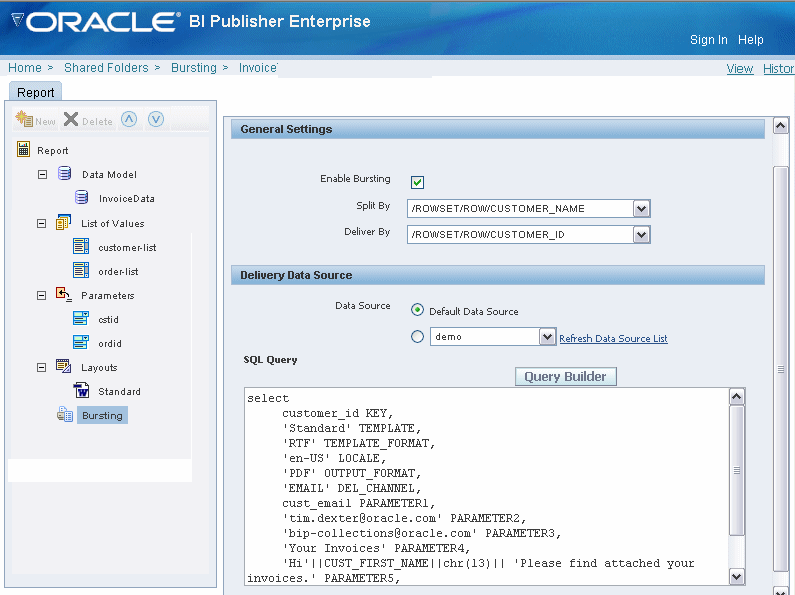
The report will be burst and delivered via e-mail. The template, template format, locale, output format, delivery channel, and customer e-mail address are all specified in elements from the delivery data source and will be returned by the query. The SQL to generate the delivery XML for this example is as follows:
select distinct CUSTOMER_ID KEY, CST_TEMPLATE TEMPLATE, TMPL_TYPE TEMPLATE_FORMAT, CST_LOCALE LOCALE, CST_FORMAT OUTPUT_FORMAT, CST_DEL_CHAN DEL_CHANNEL, CST_EMAIL PARAMETER1, 'accounts.receivable@oracle.com' PARAMETER2, 'bip-collections@oracle.com'PARAMETER3, 'Your Invoices' PARAMETER4, 'Hi'||CUST_FIRST_NAME||chr(13)|| 'Please find attached your invoices.' PARAMETER5, 'true' PARAMETER6, 'donotreply@nowhere.com' PARAMETER7 from customers
For information on running the report, see Scheduling a Report to Be Burst.
This section describes how to call a BI Publisher report via a URL from another application, for example from a portal or from an Application Express application.
In the BI Publisher security model, reports are placed in folders and those folders are then secured to a role and a role assigned to a user. For a user to successfully access the report, you must ensure that the user is credentialed within BI Publisher to see it. There are two options for this:
Use the Guest folder
Enable the Guest folder via the Security Configuration tab of the Security Center page (for more information see Allowing Guest Access). Any report in this folder is open to all users to see and run. Use this option if the report does not contain sensitive data.
Use SSO
If both the calling application and BI Publisher are configured as partner applications in an SSO server, you can call any report via a URL and as long as the user has rights to see or run the report, then BI Publisher will render it without the need for the user to log in. For more information on setting up security options, see Defining a Security Model.
The basic URL for a report is as follows:
http://<server:port>/xmlpserver/<ReportDirectory>/<ReportName>.xdo
where
server:port - is the name of the server and port number where BI Publisher is running
xmlpserver - is a required string (the name of the application)
ReportDirectory - is the folder path to the report
Important: On the BI Publisher server, a report resides in a folder named for the report. For example, assume you have a report called Salary Report. On your BI Publisher desktop it is located in a folder of reports called Executive. Within Executive, it is located in a folder called Private. The path to this report would therefore be
Executive/Private/Salary+Report
Note that you must replace a space in the folder or report name with the + character.
ReportName.xdo - is the name of the report with the .xdo extension.
This will render the complete report inside the BI Publisher page with all the report controls. The default template, output and parameters will be used to render the report. For example:
http://xdopf.us.oracle.com:9999/xmlpserver/Executive/Salary+Report/Salary+Report.xdo
server:port - xdopf.us.oracle.com:9999
xmlpserver
ReportDirectory - Executive/Salary+Report
ReportName.xdo - Salary+Report.xdo
If you want to specify parameters for your output report, such as the template, the output format, and any parameters defined for the report, you can add name/value pairs to the URL. The easiest way to generate the URL is to use the Export function from the BI Publisher View Report page. The URL generated will look similar to the basic URL described above, but the name/value pairs will be added.
For example:
http://xdopf.us.oracle.com:9999/xmlpserver/Executive/Employee+Salary+Report/Employee+Salary+Report.xdo?_xpf=&_xpt=1&_xdo=%2FExecutive%2FEmployee+Salary+Report%2FEmployee+Salary+Report.xdo&dept=10&_xt=Standard&_xf=html
The URL components through the report name are described in the previous section. The URL after the report name consists of:
?_xpf=&_xpt=1&_xdo=%2FExecutive%2FEmployee+Salary+Report%2FEmployee+Salary+Report.xdo&dept=10=*&_xt=Standard&_xf=html
Note the following standard URL syntax:
? - denotes the first parameter
& - denotes each additional parameter
The BI Publisher parameters are as follows:
_xpf - required string for internal use
_xpt - defines whether to render the report in the full BI Publisher window (as above), or to render just the report document. Valid values are
0 - uses the BI Publisher window
1- renders just the document
_xdo - (optional) provides the path to the current report
dept - this is a parameter specific to the report as defined in the report definition. In this case the department for the data. Notice it takes the department ID. The parameter definition is to show the user the department name and then pass the ID to the query. You can have multiple parameters and their values in the URL.
_xt - this controls the template to be used. This is the template name, not the template file name. In this case, the template name is "Standard".
_xf - this controls the format of the output to be generated. Valid values are same as for the report: pdf, html, excel, rtf, or data.